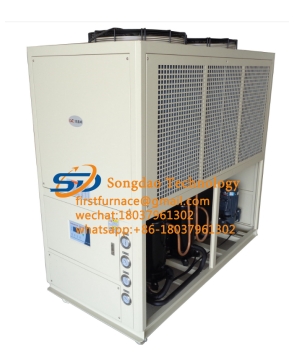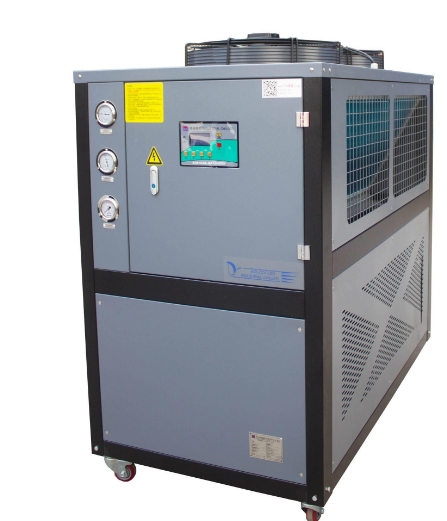- 04
- Nov
Feilsøkingsmetoden for fenomenet at kompressorvæsken treffer sylinderen i det industrielle kjølesystemet
Feilsøkingsmetoden for fenomenet at kompressorvæsken treffer sylinderen i industriell kjøler system
1. Causes of wet stroke failure
① When using manual control, the throttle valve is improperly adjusted, the opening is too large, or the float valve is not closed tightly;
②The thermal expansion valve fails, or the temperature sensing bulb is installed incorrectly, and the contact is not real, resulting in excessive opening;
③The evaporator coil is too thick and the load is too small;
④ Excessive oil accumulation in the system;
⑤Kjølekapasiteten til kompressoren er for stor, eller varmebelastningen på lageret er liten;
⑥ Feil justering av ventildrift;
⑦The refrigerant in the refrigeration system is filled with too much refrigerant;
⑧The liquid supply solenoid valve is not closed tightly;
⑨I to-trinns kompresjonskjølesyklus, når sugeventilen til lavtrykkstrinnet plutselig lukkes eller åpnes (eller antallet driftsenheter plutselig synker og øker), og i intercooleren. Serpentinspiralen kommer plutselig inn i væsken, noe som lett kan forårsake det våte slaget til høytrykkstrinnskompressoren.
Kort sagt er det mange faktorer som forårsaker kompressorens våte slag, og årsakene bør finnes ut og elimineres i henhold til den spesifikke situasjonen.

2. Instrumenter, verktøy og utstyr som brukes til å oppdage feil i våtslaget til kjølekompressoren
①Instrument: pressure gauge, multimeter, clamp meter, thermometer, double qi meter.
②Tools: wrenches, pipe expansion tools, filling valves, pointed pliers, pliers, flashlights, special tools.
③Equipment: working fluid bottle, nitrogen bottle, vacuum pump, complete set of gas welding.
3. The general operation method to detect the wet stroke failure of the refrigeration compressor
Since the refrigeration system of industrial chillers is a complex system composed of condensers, evaporators, expansion valves, and many equipment accessories that are interrelated and influencing each other, once the refrigeration device fails, one should not only focus on certain On a local level, it is necessary to conduct a comprehensive inspection and comprehensive analysis of the entire system. In a nutshell, the general method of detection is:
“One listen, two touch, three look, four analysis” a set of basic methods.
One look: look at the suction pressure and discharge pressure of the compressor; look at the cooling rate of the cooling chamber; look at the frosting state of the evaporator; look at the frosting situation of the thermal expansion valve.
Second listening: listening to the sound of the compressor running, there should be only the clear movement of the valve. When there is a “through-through” sound, it is the impact sound of liquid hammer; listen to the sound of refrigerant flowing in the expansion valve; listen to the sound of the cooling fan; listen to the sound of the solenoid valve; listen to whether there is obvious vibration in the pipeline.
Three touches: touch the temperature of the front and rear bearings of the compressor; touch the temperature of the compressor cylinder liner and cylinder head; touch the temperature of the suction and exhaust pipes. Four analysis: Use the relevant theories of the refrigeration device to analyze and judge the phenomenon, find the cause of the failure, and eliminate it in a targeted manner. The judgment of the liquid hammer failure is not only based on the frosting of the suction pipe, but mainly from the sharp drop in the exhaust temperature. At this time, the exhaust pressure will not change much, but the cylinder, crankcase, and exhaust chamber are all affected. Cold or frosty. In the case of hydraulic shock, it can damage the lubrication system, worsen the work of the oil pump, sharply shrink the cylinder wall, and pierce the cylinder head in severe cases.

4. The method of troubleshooting and restoring normal operation of refrigeration compressor wet stroke fault
Håndtering av væskesjokkulykker bør gjøres umiddelbart, og i alvorlige tilfeller bør utrykningskjøretøy utføres. Når det oppstår et lite våtslag i en ett-trinns kompressor, skal bare kompressorens sugeventil lukkes, væsketilførselsventilen til fordampningssystemet skal lukkes, eller væsken i beholderen skal reduseres. nudler. Og vær oppmerksom på oljetrykket og eksostemperaturen. Når temperaturen stiger til 50 ℃, prøv å åpne sugeventilen. Hvis eksostemperaturen fortsetter å stige, kan du fortsette å åpne den, og hvis temperaturen synker, lukk den igjen.
For the “wet stroke” of a two-stage compressor, the treatment method of the low-pressure stage wet stroke is the same as that of a single-stage compressor. But when there is a large amount of ammonia rushing into the cylinder, the high-pressure compressor can be used to depressurize and evacuate through the intercooler. Before pumping down, the liquid in the intercooler should be drained into the drain bucket, and then the pressure should be reduced. The cylinder cooling water jacket and oil should be cooled before the pressure reduction: drain the cooling water in the device or open the large water valve.
Når væskenivået i intercooleren er for høyt, viser høytrykkskompressoren et “våt slag”. Behandlingsmetoden bør først slå av sugeventilen til lavtrykkskompressoren, og deretter slå av sugeventilen til høytrykkskompressoren og væsketilførselsventilen til intercooleren. Tøm om nødvendig ammoniakkvæsken i intercooleren inn i utløpstrommelen. Hvis høytrykkskompressoren er kraftig frostet, stopp lavtrykkskompressoren. Den påfølgende behandlingsmetoden er den samme som for ett-trinns.
